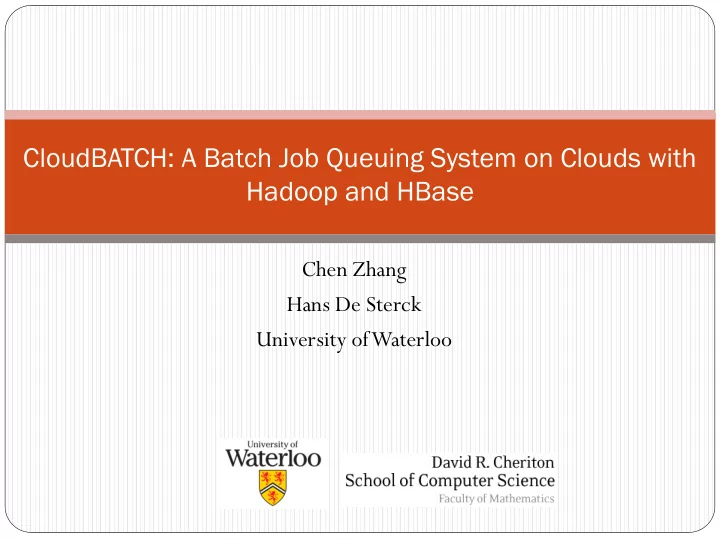

CloudBATCH: A Batch Job Queuing System on Clouds with Hadoop and HBase Chen Zhang Hans De Sterck University of Waterloo
Outline Introduction Motivation Related Work System Design Future Work
Introduction - Motivation Users have hybrid computing needs Legacy programs dispatched by traditional cluster systems MapReduce programs requiring Hadoop Hadoop is incompatible with traditional cluster management systems Hadoop is yet another system to manage cluster machines Administrative barriers for deploying dedicated Hadoop cluster on existing cluster machines Using Hadoop on public clouds (Amazon) is not cost-effective for large scale data processing tasks CloudBATCH makes it possible to Use Hadoop to manage clusters for both legacy and MapReduce computing needs
Introduction – CloudBATCH CloudBATCH is built on top of Hadoop (job execution) and HBase (META-data management) with a scalable architecture where there is no single point of failure What CloudBATCH can do Batch job queuing for legacy applications besides MapReduce jobs Job queue management with individually associated policies, user access control, job priority, pre-scheduled jobs, etc. Transparently handle jobs with simple non-NFS file staging needs Task level fault tolerance against machine failures Work complementarily with Hadoop schedulers, such as setting the minimum number of node allocation guaranteed to each queue The HBase table records can also serve as a good basis for future data provenance supports What CloudBATCH cannot do MPI-type jobs, reserve actual compute nodes, etc.
Introduction - Related Work (1) Hadoop Schedulers Focus on optimizing task distribution and execution Do not provide rich functionality for cluster level management, such as user access control and accounting, and advanced job and job queue management Hadoop On Demand (HOD) Creates a Hadoop cluster on-the-fly by running Hadoop daemons through the cluster resource management system on a set of reserved compute nodes Does not exploit data locality for MapReduce jobs because the nodes where the Hadoop cluster is created on may not host the needed data at all Sun Grid Engine (SGE) Hadoop Integration
Introduction - Related Work (2) Sun Grid Engine (SGE) Hadoop Integration Claims to be the first cluster resource management system with Hadoop integration Creates a Hadoop cluster on-the-fly like HOD with better data locality concerns Potential risks of overloading a compute node as a result of catering for data locality concerns (non-exclusive node usage) Shares a major drawback with HOD: a possible significant waste of resources in the Reduce phase, or in the case of having unbalanced executions of Map tasks Because the size of the on-the-fly cluster is statically determined at the beginning by users, normally according to the number of Map tasks On-the-fly Hadoop cluster is not shared across job submissions
System Design - Overview
System Design – Client Clients accept job submission commands from users Check user credentials , determine queue/job policy, add job to CloudBATCH system by inserting job information into an HBase table called “Job Table”
System Design – Broker and Monitor Brokers constantly poll the Job Table for a list of jobs with “Status:submitted” status For every job on the list Changes the job status to “Status:queued” Submits to the Hadoop MapReduce framework a “Wrapper” program for job execution Note: if the Wrapper fails directly after being submitted, jobs could stay in “Status:queued” forever. This is handled by the “Monitor” program Monitors set a time threshold T, periodically poll the Job Table for jobs that stay in the “Status:queued” status for a time period longer than T, and change their status back to “Status:submitted”
System Design – Wrapper Wrappers are Map-only MapReduce programs acting as agents to execute user programs at compute nodes where they are scheduled to run by the underlying Hadoop schedulers When a Wrapper starts at some compute node: Grabs from the HBase table the necessary job information and transfers files that need to be staged to the local machine Updates the job status to “Status:running” Starts the job execution through commandline invocation, MapReduce and legacy jobs alike During job execution: Checks the execution status such as total running time to follow job policies, and terminates a running job if policies are violated After job execution completes: Either successful or failed, the Wrapper will update the job status (“Status:successful” or “Status:failed”) in the Job Table, Performs cleanup of the temporary job execution directory Terminates itself normally
System Design - Discussion Limitations No support for MPI-type applications Jobs must be commandline based, no interactive execution Data consistency under concurrent access Guard against conflicting concurrent updates to Job Table Multiple Brokers updating conflicting job status Solution: use transactional HBase with snapshot isolation Performance bottleneck Multiple number of system components (Brokers, etc.) can be run according to the scale of the cluster and job requests The bottleneck is at how fast concurrent clients can insert job information to the Job Table
Future Work Monitors are still not fully explored for our prototype and may be extended in the future for detecting jobs that have been marked as “Status:running” but actually failed Further test the system under multi-queue, multi-user scenarios with heavy load and refine the prototype implementation for trial production deployment in solving real-world use cases Exploit the usage of CloudBATCH to make dedicated Hadoop clusters useful for the load balancing of legacy batch job submissions to other coexisting traditional clusters
Thank you! And Questions? Please contact me at: c15zhang@cs.uwaterloo.ca Thank you!
Recommend
More recommend